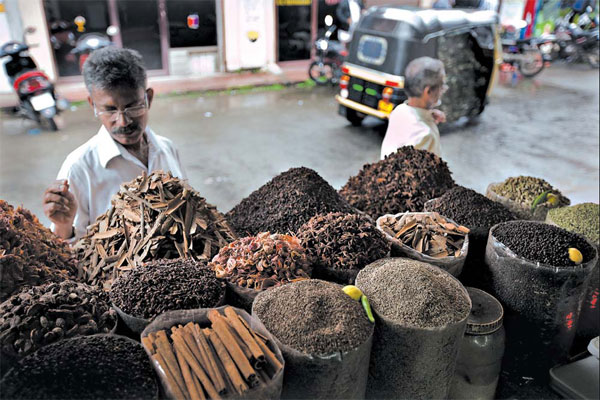Tainted spices force farming change
Updated: 2013-09-08 07:39
By Gardiner Harris(The New York Times)
|
|||||||
IDUKKI, India - Spices grown in the mist-shrouded Western Ghats here have fueled wars, fortunes and even the discovery of continents, and for thousands of years farmers harvested them in the same traditional ways. Until now.
Science has revealed that instead of improving health, spices sometimes make people very sick, so Indian officials are pushing changes in the way farmers pick, dry and thresh their bounty.
The United States Food and Drug Administration will soon release an analysis that pinpoints imported spices, found in just about every kitchen in the Western world, as a potent source of salmonella poisoning.
In a study of more than 20,000 food shipments, the food agency found that nearly 7 percent of spice lots were contaminated with salmonella, twice the average of all other imported foods. Some 15 percent of coriander and 12 percent of oregano and basil shipments were contaminated, with high contamination levels found in sesame seeds, curry powder and cumin. Four percent of black pepper was contaminated.
|
India is trying new ways of handling spices to prevent contamination. A spice shop in Kochi and a worker, below, with cardamom pods. Photographs by Graham Crouch for The New York Times |

Each year, 1.2 million people in the United States become sick from salmonella. More than 23,000 are hospitalized and 450 die.
Mexico and India had the highest share of contaminated spices. About 14 percent of the samples from Mexico contained salmonella, the study found, a result Mexican officials disputed.
India's exports were the second-most contaminated, at about 9 percent. But India ships nearly four times the amount of spices to the United States that Mexico does, so its contamination problems are particularly worrisome, officials said.
Westerners are particularly vulnerable to contaminated spices because pepper and other spices are added at the table. Bacteria do not survive high temperatures, so contaminated spices present fewer problems when added during cooking, as is typical in the cuisine of India and most other Asian countries.
Mexico's chief of food safety inspections insisted that Mexican spices are checked daily and are safe. "We have a constant, daily scheme of verification" of food products, said Alvaro Perez Vega, at Mexico's Federal Commission for the Protection Against Sanitary Risk.
In India, the world's largest producer, consumer and exporter of spices, government officials are taking Washington's concerns seriously. "The world wants safe spices, and we are committed to making that happen," said Dr. A. Jayathilak, chairman of the Spices Board of India.
Illnesses caused by spices are hard to trace. But new DNA sequencing of salmonella types is allowing officials to pinpoint spices as a cause of outbreaks, including one in 2010 involving black and red pepper that sickened more than 250 people in 44 states.
The United States is one of the world's largest spice importers, bringing in 326 metric tons in 2012 valued at $1.1 billion, according to its Department of Agriculture. Of those imports, which account for more than 80 percent of the total United States spice supply, 19 percent were from India and 5 percent from Mexico.
New rules allow the agency to restrict food imports if it even suspects the food is unsafe.
On a tour through a tropical landscape teeming with pepper and cardamom farms, Indian spice officials showed some voluntary changes they are pushing.
The first stop was Noble Joseph's four-hectare pepper farm, several hours from the port city of Kochi, in the state of Kerala.
Mr. Joseph's hilly farm is dominated by slim silver oaks and erythrina trees planted every 2.4 meters; each tree is encircled by four or five pepper vines.
During harvest season, workers use bamboo ladders to pluck the pepper seeds from the vines as high as 12 meters.
Pepper farmers used to dry the seeds on bamboo mats or dirt floors and then gather them for manual threshing. Dirt, dung and salmonella were simply part of the harvest, so much so that in 1987, the F.D.A. blocked shipments of black pepper from India. The ban was lifted two years later, after the Indian government began a testing program.
Now, the Josephs boil their harvest in water to clean the kernels, and to speed drying and encourage a uniform color. They are then placed on tarps spread over a concrete slab with nets above to catch bird droppings.
At another spice farm, in the village of Chemmanar, Bipin Sebastian is transitioning to organic farming in hope of earning a premium price for his pepper, cloves, cardamom, turmeric and coffee.
Mr. Sebastian said: "Now, we put down tarps and netting over it to protect it from the birds. And I've been getting a higher price. It's been great."
Hari Kumar and Karla Zabludovsky contributed reporting.
The New York Times
(China Daily 09/08/2013 page11)
